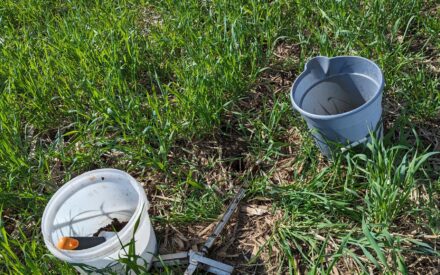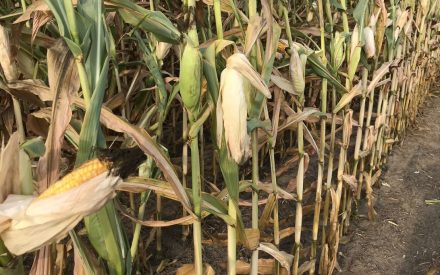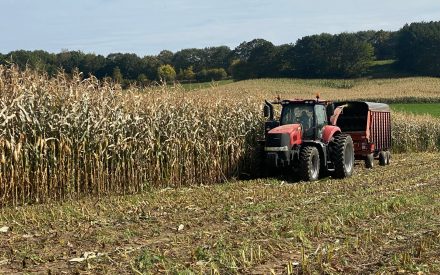Surface broadcasting of seed in late winter or frost seeding is a common practice that minimizes equipment expenses and erosion concerns over tillage practices. While less reliable than seeding with a drill, frost seeding is commonly used to increase plant diversity, forage yield, and reduce weed pressure. Species for successful frost seeding into pastures need to have certain characteristics such as rapid germination, superior seedling vigor, aggressive tillering and competitive ability, that would allow them to compete with the existing vegetation while being established.
What species are good candidates to frost seed?
Successful frost seeding relies on cycles of freeze/thawing in late winter and early spring to improve soil-to-seed contact. Many grasses and legumes can be seeded using this method:
Grasses
Research results in multiple locations in Wisconsin (Arlington, Lancaster) suggest that, orchardgrass and perennial ryegrass, among grasses, tend to have early spring growth and dense ground cover. This early growth results in good weed suppression due to unfavorable environment for annual grasses. Bromegrass, timothy and reed canarygrass were shown to have lower occurrence in the seeding year resulting in more open space for annual grasses to grow. Orchardgrass showed better suppression of quackgrass than reed canarygrass or smooth bromegrass.
Smooth bromegrass, timothy, and reed canarygrass require energy to develop their reserve storage structures of rhizomes and lower stems sections (haplocorms), which appears to limit the ability to produce new tillers and aboveground dry matter in the seeding year. However, these structures result advantageous for long-term development of the stand. The Wisconsin study suggest that bromegrass and timothy could be frost-seeded at lower rates than orchardgrass or perennial ryegrass because of the increased capacity for vegetative reproduction, but results will be seen in second year (thus they are not recommend for frost seeding).
Legumes
Among legumes, red clover and birdsfoot trefoil have been reported by farmers and research (Wisconsin) as good candidates for frost seeding. Grass sod suppression is critical to effective seeding. Mowing or overgrazing can be done in the fall. Seeding early in spring is preferred over fall or overwinter seeding because of seed lost to wildlife consumption. Additional grazing or mowing in the spring will be needed after seeding but before clover or trefoil emergence.
Alfalfa, white or ladino clover, and alsike clover have been frost seeded with varying successful outcomes. Research in the upper Midwest testing different cultivars of alfalfa and frost seeding showed that less dormant varieties will tend to germinate early and if followed by low lethal temperatures, the frost seeded alfalfa seedling could die. On the contrary, the more dormant varieties tend to germinate later in the season escaping the risk of winterkill. Important if choosing alfalfa for frost seeding is to consider varieties with a combination of good winter survival, dormant types and pest resistance.
Table 1. Frost seeding suggested seeding rates into an existing grass or legume sod (source: UW-Madison Extension)
| Species | Seed Alone | As part of seed mixture |
Expected Established Plants (Plants/square foot) |
| Rate (lbs/acre) | |||
| Legumes | |||
| Red clover | 4-8 | 3-4 | 2-5 |
| Birdsfoot Trefoil | 4-6 | 2-3 | 6-9 (second year) |
| Alfalfa | 5-8 | 3-4 | 4-6 |
| Ladino clover | 2-3 | 1-2 | 1-2 |
| Alsike clover | 2-4 | 1-2 | 2-3 |
| Grasses | |||
| Ryegrass (perennial/Italian) | 8-15 | 2-3 | 10-12 |
| Orchardgrass | 3-4 | 1-2 | 4 |
| Tall Fescue | 6-8 | 3-4 | 3-4 |
| Smooth bromegrass | Not recommended for frost seeding | ||
| Reed canarygrass | Not recommended for frost seeding | ||
| Timothy | Not recommended for frost seeding | ||

 ▶ AI in Agriculture
▶ AI in Agriculture ▶ Evaluating MRTN Rates for Corn Grain and Silage After Manure Application
▶ Evaluating MRTN Rates for Corn Grain and Silage After Manure Application ▶ Practices to Optimize the Nutritive Value of Corn Silage
▶ Practices to Optimize the Nutritive Value of Corn Silage ▶ Explore the New Corn Silage Dry Down Monitoring Tool
▶ Explore the New Corn Silage Dry Down Monitoring Tool


